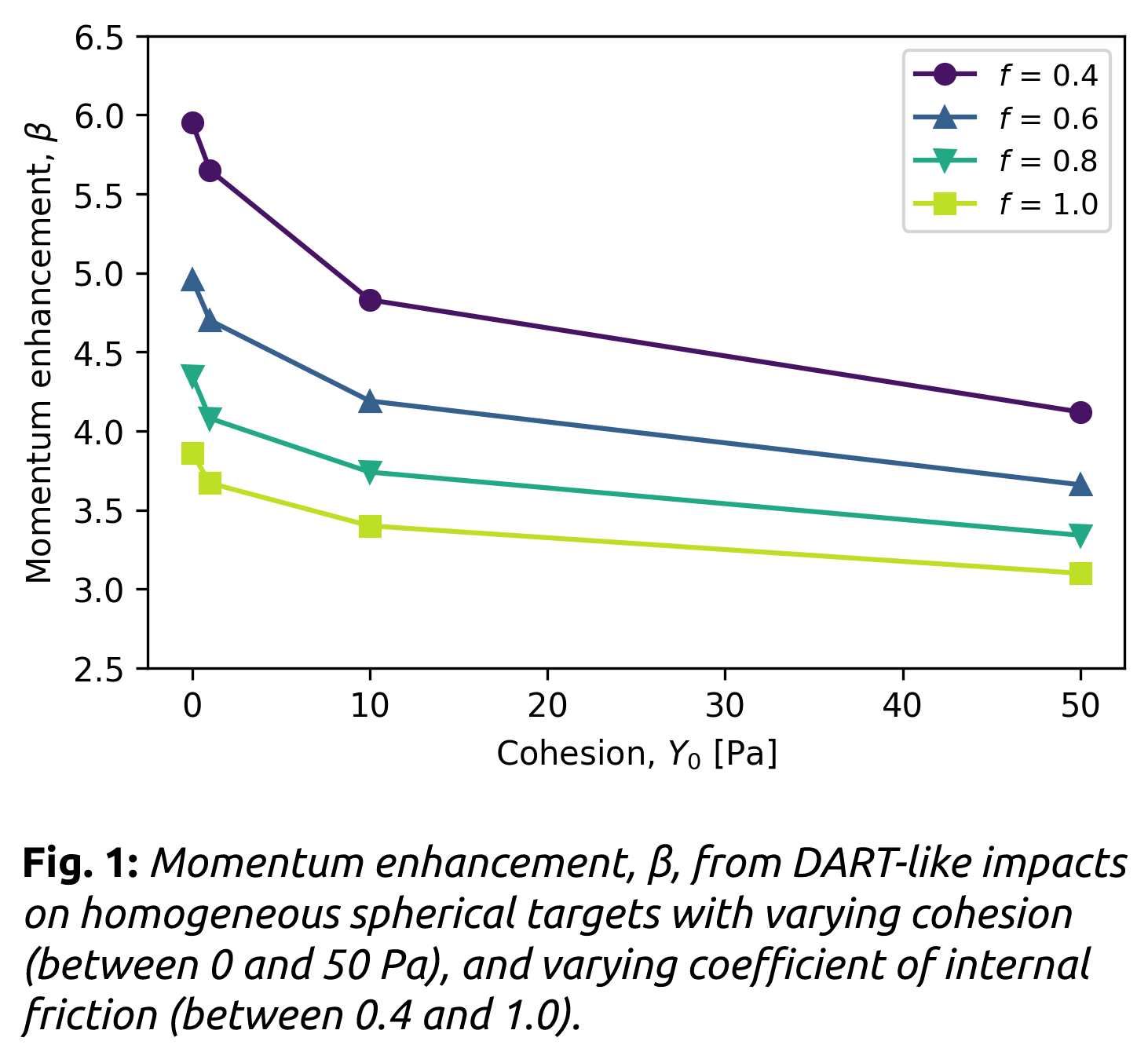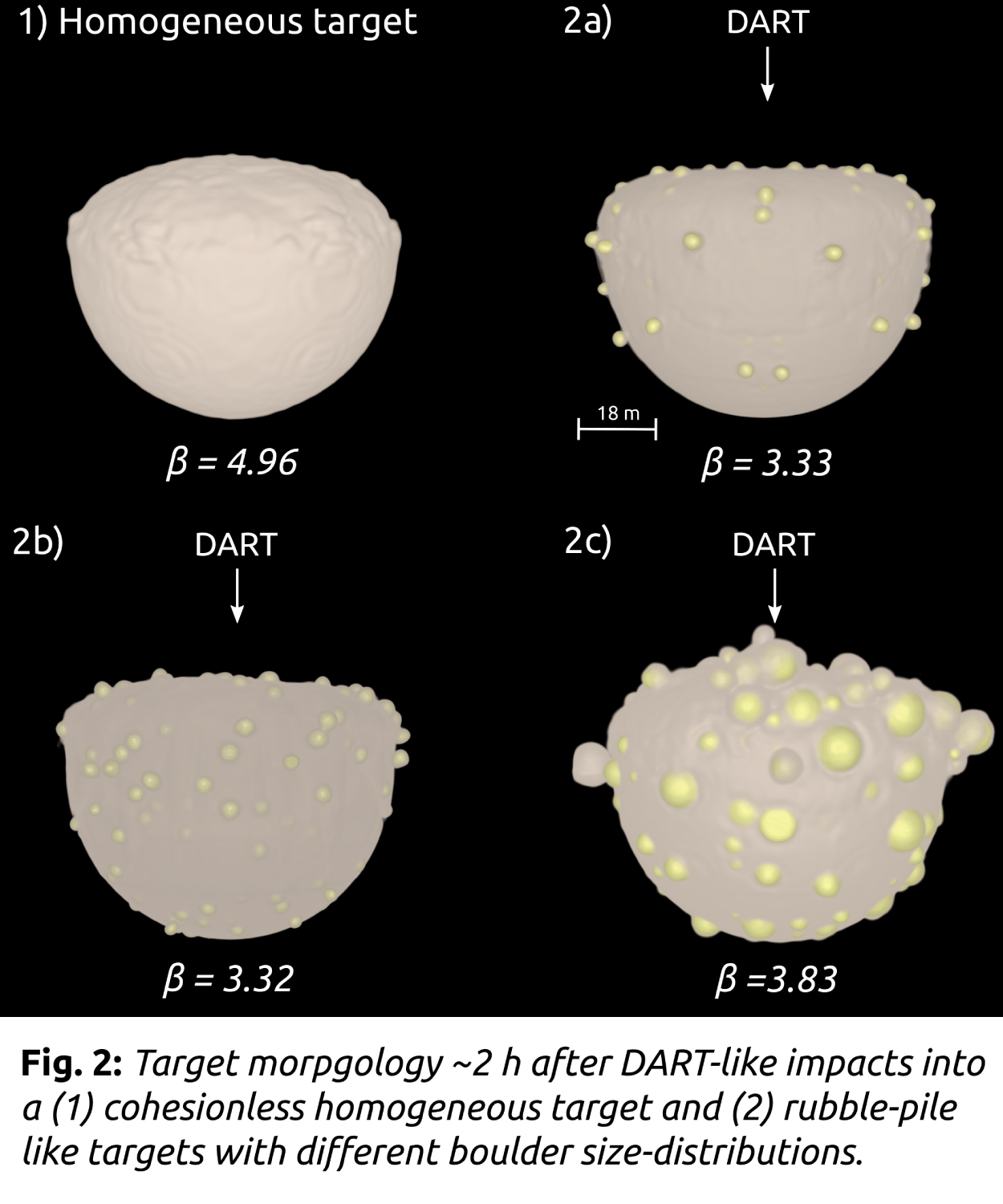Asteroid-scale consequences of the DART impact: the role of target strength and heterogeneity
- University of Bern, Space Research and Planetary Sciences, Physikalisches Institut, Bern, Switzerland (sabina.raducan@space.unibe.ch)
Introduction: NASA’s Double Asteroid Redirection Test (DART) aims to test a controlled deflection of a Near-Earth asteroid, by impacting the smaller component of the 65803 Didymos asteroid system, Dimorphos. ESA’s Hera mission [1] will arrive at Dimorphos several years after the DART impact and will perform detailed characterisation of Dimorphos and of the impact outcome.
Past studies of the DART impact outcome [e.g., 2–4] have shown that the amount by which Dimorphos can be deflected is strongly dependent on its surface, subsurface and internal properties. Moreover, [4] showed that in order to validate the predictive capabilities of our numerical models and to understand and ultimately reproduce the asteroid deflection technique, we need a measure of both the impact deflection efficiency (often referred to in terms of β, where β = change in momentum of the asteroid/impactor momentum) and the crater size and morphology. Small asteroids, of less than ~10 km in diameter, are believed to be rubble-pile objects, aggregates held together only by self-gravity or small cohesive forces [5]. Moreover, recent results of the SCI impact on Ryugu [6] inferred that at least the near-surface of the asteroid may not be dominated by strength and impact events are controlled to a large extent by gravity, despite its very low value. These findings might also be applicable to Dimorphos. Studies by [7] suggest that for a low cohesion target, an impact on the same magnitude as DART might have a large enough specific impact energy to cause global deformation of the target.
Here we numerically simulate DART-like impacts on weak homogeneous and rubble-pile asteroids that use realistic material models and aim to evaluate the resulting target morphology and the global shape change caused by such impacts. Additionally, we aim to quantify the deflection efficiency, given different target scenarios.
Numerical Model: Here we use Bern’s parallel Smooth Particle Hydrodynamics (SPH) impact code [8, 9] to model DART-like impacts (500 kg projectiles at 6 km/s) on spherical asteroid targets, and track the evolution of the target for up to 2 hours after the impact. Bern’s SPH code has been previously validated against laboratory experiments and benchmarked against other codes [e.g., 10, 11]. Recently, the code has been validated against laboratory experiments of impacts into heterogeneous targets [12]. To quantify the effects of the target properties and structures on the post-impact morphology, degree of shape change and on the momentum transfer efficiency, we considered the following target scenarios:
1) Homogeneous spherical targets with low cohesion (Y0 = 0 to 50 Pa) and varying coefficient of internal friction (f = 0.4 to 1.0); To describe the shear response, the target material was modelled using a simple pressure-dependent strength model typical of pre-damaged rock materials [13]. The initial target porosity was kept constant at 40%.
2) Rubble-pile spherical targets with three different distributions of boulders, embedded into a cohesionless matrix material: 2a) grid distribution of 2.5 m in diameter boulders, with one boulder diameter spacing between each boulder in the x, y, and z directions; 2b) random distribution of 2.5 m boulders; 2c) Random distribution of boulders with random sizes between 2 and 10 m. In all rubble-pile target scenarios, the boulders had a tensile strength of YT = 1 MPa and the matrix material was modelled the same as in (1), with Y0 = 0 Pa and f = 0.6.
Results and discussion:
Homogeneous asteroids: The size and morphology of the DART crater is of paramount importance for determining the asteroid’s near-surface properties and structure. In the strength dominated impact scenarios, the cohesion is the dominant force that stops the crater cavity from growing. Therefore, with decreasing target cohesion, more material is displaced or gets ejected above escape speed. We found that for homogeneous asteroids, impacts into targets stronger than Y0~10 Pa create well defined bowl-shaped craters, while impacts into weaker targets create morphologies that do not resemble an impact crater anymore (e.g., Fig. 2, [14]). For these scenarios the curvature of the target also plays a major role. Fig. 1 shows the momentum enhancement factor, β, as a function of target cohesion, for four different coefficients of internal friction. Our results suggest that for a low friction, cohesionless target, the momentum enhancement can be as high as 6.

Rubble-pile asteroids: Fig. 2 shows the final target morphologies from DART-like impacts into a (1) cohesionless homogeneous target and (2a, b, c) rubble-pile targets with different boulder size-frequency distributions. In all four impact scenarios, the DART impact produced target morphologies that are dissimilar to cratering and changed the global morphology of the asteroid. Initial simulation results revealed that the presence of boulders in the target can decrease the deflection efficiency by up to 40% compared to an impact into a homogeneous target. At the same time, the initial boulder size-frequency distribution on the surface of the asteroid seems to also influence β.

Conclusions: The DART impact on cohesionless spherical bodies is likely to produce morphologies that are dissimilar to cratering and change the global morphology of the asteroid. Our modelling results together with future Hera mission observations will provide constraints regarding the evolution of the shapes and structures of small asteroids. Future work will investigate impact events into low-cohesion asteroids with more diverse asteroid shapes and boulder distributions.
Acknowledgements: This work has received funding from the European Union’s Horizon 2020 research and innovation programme under grant agreement No. 870377.
References: [1]Michel, P. et al. (2018) Adv Space Res. 62:2261–2272. [2]Jutzi, M. & Michel, P. (2014) Icarus, 229:247–253. [3]Raducan, S.D. et al. (2019) Icarus, 329:282–295. [4]Raducan, S.D. et al. (2020) Planet. and Space Sci. 180:104756. [5]Richardson, D.C. et al. (2002) Asteroids III, 501–515. [6]Arakawa, M. et al. (2020) Science, 368:67–71. [7]Jutzi, M. et al. (2017) A&A, 597:A61. [8]Jutzi, M. et al. (2008) Icarus, 198:242–255. [9]Jutzi, M. (2015) Planet. Space Sci, 107:3–9. [10]Jutzi, M. et al. (2009) Icarus, 201:802–813. [11]Raducan, S.D. et al. (2021) LPSC,1908. [12]Ormö, J. et al. (2021) LPSC,1965. [13]Collins, G.S. et al. (2004) Meteorit. Planet. Sci, 39:217–231. [14]Raducan, S.D. & Jutzi, M. (2021) LPSC,1900.
How to cite: Raducan, S. D. and Jutzi, M.: Asteroid-scale consequences of the DART impact: the role of target strength and heterogeneity , European Planetary Science Congress 2021, online, 13–24 Sep 2021, EPSC2021-623, https://doi.org/10.5194/epsc2021-623, 2021.

